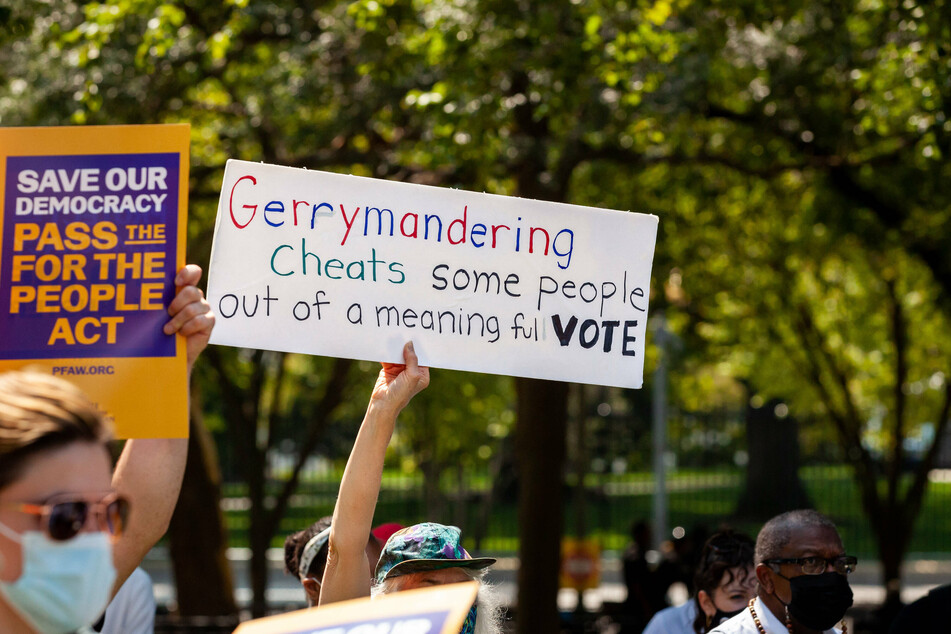Gerrymandering: How Texas Republicans are poised to pick their own voters
Austin, Texas – As Texas ramps up for its decennial redistricting process with hearings starting this week, Democrats around the country are steeling themselves for a difficult fight in the 2022 midterms.

Redistricting is a process that happens every 10 years using demographic data gathered from the US Census. States take that block-by-block information and use it when redrawing electoral maps for the coming decade.
The maps have enormous political consequences, as they determine how the 435 seats in the US House are distributed among states, as well as how the districts themselves are divided within states.
Each district on the map must have an almost-equal number of residents, but there are a surprising number of different ways mapmakers can divide populations – and even small changes can have a dramatic impact on election results.
In some states, independent commissions draw the maps, but in many key states like Texas – the only one to gain two congressional seats in the current cycle – redistricting remains in the control of the state legislature and governor.
The process has Democrats worried because they only have a very thin majority in the House as is. Republicans only need to flip five seats to regain control of the lower chamber in 2022.
With shortened timelines due to the Covid-19 crisis, advocates are concerned that many redistricting decisions will be made behind closed doors, providing even fewer opportunities for public input and oversight.
At the same time, the slew of Republican-backed suppressive voting bills passed in states like Texas has heightened attention around redistricting as the 2022 midterms approach.
Though both major US political parties employ partisan maneuvers in redistricting, Republicans are widely considered to have the advantage in the current cycle.
But how exactly will Republicans in Texas and around the country manipulate maps in their favor, and how is such partisan map-drawing permitted under US law?
How does partisan redistricting work?

Political parties have a number of methods to control redistricting, a process often referred to as partisan gerrymandering.
The demographic data gleaned from the Census, including area of residence, age, race, educational background, and more, can tell data scientists a lot about probable voting patterns.
That means that without actually knowing your party affiliation, they can get a pretty good guess how you will vote.
They then use that information to engage in two primary processes of dividing voters into districts, commonly dubbed cracking and packing.
Cracking involves the political party in power breaking up people likely to vote for the other party into separate districts so they are unable to achieve a majority.
Packing is essentially the opposite: putting more people likely to vote for the other party in the same district to weaken their individual voting power. Though the opposing party may win that district by a landslide, other districts become far less competitive as a result.
A third process, called stacking, involves creating districts that are evenly divided between lower-income voters of color, who typically vote for Democrats, and higher-income, educated whites, who are more likely to vote for conservative candidates. Because the higher-income crowd typically has better turnout for elections, Republicans often benefit from this method.
With the help of increasingly sophisticated computer algorithms, mathematicians are able to generate thousands of maps using hyper-specific cracking, packing, and stacking techniques. Many times – but not always – gerrymandered maps can be spotted by the very irregular shapes of districts.
When one political party dominates the legislature and governorship, as is the case in Texas, politicians in the controlling party can essentially take their pick of the maps most likely to benefit them – all but writing their own electoral success.
Although dividing populations with the intention of discriminating based on race is illegal, it's often very difficult to prove in practice.
Legal basis and challenges

Strategies like these, which cement electoral gains, seem like they should be illegal – or at least tightly restricted – under federal law.
But as of 2019, the Supreme Court ruled that there is no limit on a political party's use of partisan gerrymandering tactics to secure their own advantage in redistricting.
That means this is the first cycle in which instances of gerrymandering cannot be challenged in federal court on the basis of partisanship.
Still, that hasn't stopped Democrats and advocates of fair map-drawing practices from attempting their own legal challenges in the current redistricting cycle.
In Texas, for example, Democrats have already filed a lawsuit to stop the special session on redistricting, arguing that the state's constitution requires the process to occur during a regular legislative session, according to The Dallas Morning News.
If they are successful, that would push back redistricting until 2023 – after the midterm elections.
Democrats at the national level are also trying to outlaw partisan gerrymandering through the For the People Act (FTPA), a broad piece of legislation that contains a host of federal electoral reforms to outweigh suppression at the state level.
But under current US Senate rules, 60 lawmakers must sign on for most legislation to pass. Democrats currently don't have enough senators to overcome that threshold without some Republican support.
So far, no Senate Republicans have agreed to support the FTPA, which makes it very unlikely the bill will pass before the current redistricting cycle ends.
Cover photo: IMAGO / NurPhoto

